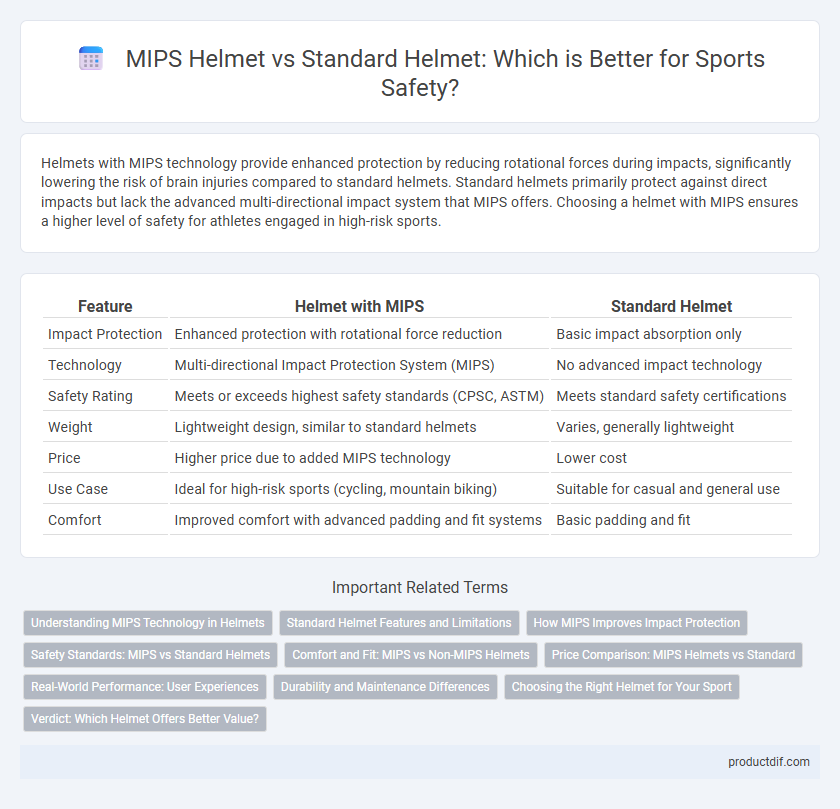Helmets with MIPS technology provide enhanced protection by reducing rotational forces during impacts, significantly lowering the risk of brain injuries compared to standard helmets. Standard helmets primarily protect against direct impacts but lack the advanced multi-directional impact system that MIPS offers. Choosing a helmet with MIPS ensures a higher level of safety for athletes engaged in high-risk sports.
Table of Comparison
| Feature | Helmet with MIPS | Standard Helmet |
|---|---|---|
| Impact Protection | Enhanced protection with rotational force reduction | Basic impact absorption only |
| Technology | Multi-directional Impact Protection System (MIPS) | No advanced impact technology |
| Safety Rating | Meets or exceeds highest safety standards (CPSC, ASTM) | Meets standard safety certifications |
| Weight | Lightweight design, similar to standard helmets | Varies, generally lightweight |
| Price | Higher price due to added MIPS technology | Lower cost |
| Use Case | Ideal for high-risk sports (cycling, mountain biking) | Suitable for casual and general use |
| Comfort | Improved comfort with advanced padding and fit systems | Basic padding and fit |
Understanding MIPS Technology in Helmets
MIPS technology in helmets incorporates a low-friction layer that allows the helmet to slide relative to the head during angled impacts, reducing rotational forces that can cause brain injuries. Standard helmets lack this feature, offering protection primarily against direct linear impacts without mitigating rotational movement. Understanding MIPS helps consumers choose helmets that provide enhanced safety by addressing multiple directions of impact in sports and cycling activities.
Standard Helmet Features and Limitations
Standard helmets typically feature a rigid outer shell with foam padding designed to absorb impact energy during collisions, offering essential protection against head injuries in sports. These helmets provide basic safety but lack the rotational impact protection that advanced systems like MIPS (Multi-directional Impact Protection System) deliver, making them less effective at reducing the risk of concussions caused by angular forces. Standard helmets may also have limited ventilation and comfort features compared to newer models with integrated technologies.
How MIPS Improves Impact Protection
MIPS (Multi-directional Impact Protection System) technology enhances helmet safety by reducing rotational forces during angled impacts, which standard helmets typically do not address. This system allows the helmet's outer shell to slide relative to the liner, mimicking the brain's natural protection against rotational motion and thereby minimizing the risk of traumatic brain injuries. Studies show helmets with MIPS can decrease rotational impact forces by up to 40%, making them a superior choice for improved impact protection in sporting activities.
Safety Standards: MIPS vs Standard Helmets
MIPS helmets incorporate a Multi-directional Impact Protection System designed to reduce rotational forces on the brain during angled impacts, enhancing safety beyond standard helmets. Standard helmets primarily focus on absorbing linear impacts and meet baseline safety certifications like ASTM, CPSC, and EN1078, but lack rotational impact mitigation. Studies indicate MIPS-equipped helmets can significantly lower the risk of concussion by addressing multi-directional forces, setting a higher benchmark in protective performance for sports safety gear.
Comfort and Fit: MIPS vs Non-MIPS Helmets
MIPS helmets provide enhanced comfort by incorporating a low-friction slip plane that reduces rotational forces during impact, which standard helmets lack. The design of MIPS helmets often includes adjustable padding and ventilation systems tailored to improve fit and airflow, minimizing pressure points and heat buildup. Non-MIPS helmets typically offer a more rigid fit without the advanced alignment features, potentially compromising long-term comfort during extended wear.
Price Comparison: MIPS Helmets vs Standard
MIPS helmets typically cost 20-30% more than standard helmets due to the advanced multi-directional impact protection system integrated in their design. Standard helmets offer basic safety features at a lower price point, usually ranging from $50 to $100, while MIPS helmets often start at around $80 and can exceed $200 depending on brand and model. The price premium for MIPS helmets reflects enhanced brain injury prevention technology valued by serious cyclists and athletes prioritizing safety.
Real-World Performance: User Experiences
Helmets equipped with MIPS technology demonstrate enhanced rotational impact protection compared to standard helmets, as reported in numerous user reviews across cycling and skiing communities. Real-world performance indicates that MIPS helmets reduce brain injury risk by allowing slight multidirectional movement during impacts, which standard helmets typically lack. Users frequently highlight increased confidence and improved safety perception when wearing MIPS helmets in high-impact sports scenarios.
Durability and Maintenance Differences
Helmets equipped with MIPS (Multi-directional Impact Protection System) feature advanced materials that enhance durability by reducing rotational forces during impacts compared to standard helmets. The maintenance of MIPS helmets often involves careful inspection of the sliding liner technology, which requires gentle cleaning to preserve its effectiveness, while standard helmets typically demand routine checks for shell cracks and padding wear. MIPS helmets may incur slightly higher upkeep costs due to specific replacement components, but both types benefit from regular safety inspections to maintain optimal performance.
Choosing the Right Helmet for Your Sport
Choosing the right helmet for your sport significantly impacts safety and performance, with MIPS (Multi-directional Impact Protection System) helmets offering advanced rotational impact protection compared to standard helmets that mainly protect against linear impacts. MIPS technology reduces rotational forces during angled impacts, making it ideal for high-risk sports like mountain biking, skiing, and motorcycling where falls often involve twisting motions. Evaluating the specific sport's impact patterns helps determine if the added protection of a MIPS helmet justifies its typically higher cost over standard models.
Verdict: Which Helmet Offers Better Value?
Helmets with MIPS technology provide enhanced protection by reducing rotational forces during impacts, making them a superior choice for safety compared to standard helmets. While MIPS helmets typically come at a higher price point, their advanced safety features justify the investment, especially for serious athletes or frequent riders. Standard helmets may offer cost savings but lack the added benefit of MIPS, resulting in lower overall value for those prioritizing maximum head protection.
Helmet with MIPS vs Standard Helmet Infographic

 productdif.com
productdif.com